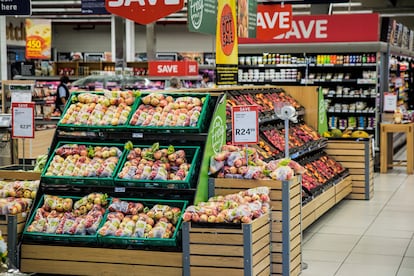‘There are no good or bad foods’ and other lies the food industry tells you
The great victory of the manufacturers of unhealthy products consists in passing false notions as facts, such as the myth that eating everything ‘in moderation’ is good for you

Packaging with aggressive attraction tactics. Unbridled, unashamed advertising. Food environments that increase the risk of non-communicable diseases and stores where the placement of even the tiniest piece of chewing gum has been carefully studied. Out there, we are exposed to all kinds of stimuli aimed at influencing the contents of our shopping cart, and it is hard not to end up lost. To quote my colleague Laura Caorsi, “the supermarket is hostile territory.”
It is not easy to realize what is going on, or to accept just how vulnerable, how easily influenced we can be; even if no one is pointing a gun at your head, the decision to put a jumbo bag of chips in your cart is not entirely rational. We rebel against the idea that our alleged freedom of choice is only a mirage.
Maybe we are aware of the situation, and so we equip ourselves with whatever tools we can: we read blogs, download the latest label-reading apps, follow influencers who analyze different products. Then we head to the store thinking that we are prepared to compete against thousands of food marketing professionals, when in reality we are but a humble David facing a mighty Goliath. But hey, at least we try.
However, we do not take into account the fact that the strategy to influence our diet has a deeper layer. The process to shape our shopping basket was forged long before a company decided to launch some irresistible supernutritious snacks or the ultimate healthy chocolate. George Lakoff, a researcher in cognitive linguistics and author of Don’t Think of an Elephant! describes frames as “mental structures that shape the way we see the world,” and it turns out that a part of the food industry has spent decades creating a frame that favors them.
The triumph (and risks) of an imperceptible strategy
The most radical success of that part of the food industry does not consist in keeping an unhealthy product as a bestseller for years, nor in taking labeling advertising to the limit by walking the fine line that keeps it from breaking the law. Not even in being able to influence political decisions. Of course, they do all this, but they are merely circumstantial strategies that are restricted to a time frame, a political setting or the current food trends.
Their great victory consists in instilling false ideas in the population, at such an unfathomable level that they are never questioned. Unchallengeable messages that turn into convictions and become part of the general knowledge. Phrases that are embedded in our culture and that we, without even realizing it, use in our conversations without ever stopping to think about where they came from – or if they even have any basis whatsoever.
No, don’t eat a little bit of everything
Perhaps you have found yourself repeating clichés like “there are no good or bad foods,” “you have to eat everything in moderation,” “your diet has to be varied and balanced” or “the problem is not what we eat, but that we don’t move enough.” Point for the industry!

The ability of these messages to permeate society is so global that it transcends contexts and countries. The renowned nutrition researcher Marion Nestle denounced it as early as 2002 in her famous book Food Politics (fundamental reading for anyone who wants to know the influence of the food industry on our way of eating), where she wrote: “It is in the interest of food companies to have people believe that there is no such thing as a ‘good’ food (except when it is theirs); that there is no such thing as a ‘bad’ food (especially not theirs); that all foods (especially theirs) can be incorporated into healthy diets; and that balance, variety, and moderation are the keys to healthful diets — which means that no advice to restrict intake of their particular product is appropriate.” Sounds familiar?
So what is ‘moderation’?
“The less, the better” is a pretty clear message. So is “avoid” or “limit” certain foods. They are unequivocal phrases that leave no room for personal interpretations and automatically generate the idea that “this food is not good for me.” If they told you to “try not to eat it,” there are no half measures: there is no line that rates foods from 0 to 10 for you to place it where you see fit (somewhere in the middle, if possible).
However, these expressions do not dominate the recommendations we hear every day. On the contrary. Subjective formulas, words and phrases with no definition have been intentionally used, with concepts that are impossible to quantify: “eat in moderation,” or “variety is important, you should eat a little bit of everything.” It is a gray area as well as a message that is very easy to transmit and adopt: it sounds reasonable, it appears to depart from radicalism (what nutritionist hasn’t been called a Nazi for stating something as obvious as “there is no amount of safe alcohol” or “we must reduce the consumption of meat”?), it does not make anyone uncomfortable and gives the false impression of empowering the consumer to make their own decisions “without paternalism.” It is a perfect move.
Why? Because what appears when we dig a little into the interpretation that each person makes of concepts like “moderation” is that everyone adapts the definition of “moderate” to their own dietary guidelines and – no surprise here – we all think that our consumption is always below what we consider to be moderate.
It also does not help that we take the way that those around us eat as a reference, when it turns out that, as my colleague Laura Casanova – with whom I agree 100% – says, “eating badly is so normalized, that eating well is called dieting.” These findings are collected in the study “How do people define moderation?” published in the journal Appetite in 2016, where the researchers also suggest that the idea of moderation serves to resolve cognitive dissonances: if eating something unhealthy can fall within the quota of “moderate consumption,” this solves the conflict that arises when we debate between choosing a healthy food or the one that we are very clear is not a good choice.
The trap of variety
The idea of “moderation” is often complemented with the notion of “variety” in a perfect tandem: “You have to eat everything, in moderation.” This message could have made sense decades ago, when hypermarkets did not even exist and the assortment that could be bought in grocery stores was far removed from the tens of thousands of food references that we find in large stores today.

Of course, part of this growth is due to a greater supply of fresh, little processed products. But one quick look at the shelves of any store is enough to understand that what has really multiplied is the amount of ultra-processed products, which is where innovation can take place (there is not much room for imagination in cooked legumes or frozen spinach).
Eating “a little bit of everything” is just a conjurer’s trick, a mantra that is used to mislead and add to the confusion. After publishing the study Everything in Moderation – Dietary Diversity and Quality, Central Obesity and Risk of Diabetes, researcher Dariush Mozaffarian stated that “in modern diets, eating ‘everything in moderation’ is actually worse than eating a smaller number of healthy foods.”
Distraction tactics
They also tell us that the important thing is to combine food with physical activity, perpetuating the idea that all calories are equal and that everything is a matter of “compensating.” Going back to Marion Nestle, her book Unsavory Truth devotes an entire chapter to explaining how Coca-Cola has turned the spotlight to the lack of physical activity as a culprit in obesity’s rise to divert the attention from the more than proven role of sugary drinks in this public health problem.
The strategies range from funding studies that consistently find that physical activity is more effective than diet for weight control, to supporting the Global Energy Balance Network, an ostensible non-profit organization that was dissolved after the scandal that ensued when it became known how it used scientists to prop up this biased message (this investigation includes the exchange of emails between the scientists and Coca-Cola).
But let’s look at the bright side: once we know these messages are fake, it is very easy to identify the senders as part of the problem. Advertisements and labels with phrases such as “physical activity is important in a healthy lifestyle” or “eat a varied diet and move” are a red flag that leaves no room for doubt about the nutritional quality of the product you have in your hands.
Sign up for our weekly newsletter to get more English-language news coverage from EL PAÍS USA Edition
Tu suscripción se está usando en otro dispositivo
¿Quieres añadir otro usuario a tu suscripción?
Si continúas leyendo en este dispositivo, no se podrá leer en el otro.
FlechaTu suscripción se está usando en otro dispositivo y solo puedes acceder a EL PAÍS desde un dispositivo a la vez.
Si quieres compartir tu cuenta, cambia tu suscripción a la modalidad Premium, así podrás añadir otro usuario. Cada uno accederá con su propia cuenta de email, lo que os permitirá personalizar vuestra experiencia en EL PAÍS.
¿Tienes una suscripción de empresa? Accede aquí para contratar más cuentas.
En el caso de no saber quién está usando tu cuenta, te recomendamos cambiar tu contraseña aquí.
Si decides continuar compartiendo tu cuenta, este mensaje se mostrará en tu dispositivo y en el de la otra persona que está usando tu cuenta de forma indefinida, afectando a tu experiencia de lectura. Puedes consultar aquí los términos y condiciones de la suscripción digital.
More information
Últimas noticias
Maduro pleads not guilty before the federal court in New York: ‘I am still the president of Venezuela’
A new test can detect Alzheimer’s from a finger prick
UN team enters Sudanese city of El Fasher after paramilitary massacre: ‘It’s like a ghost town’
A recipe for resistance: Indigenous peoples politicize their struggles from the kitchen
Most viewed
- Gilles Lipovetsky: ‘If you want to live better and fall in love, take Prozac, don’t look to philosophy’
- Alain Aspect, Nobel laureate in physics: ‘Einstein was so smart that he would have had to recognize quantum entanglement’
- Alvin Hellerstein, a 92-year-old judge appointed by Bill Clinton, to preside over Maduro’s trial in New York
- Why oil has been at the center of Venezuela-US conflicts for decades
- Maduro’s downfall puts China’s relationship with Venezuela to the test











































